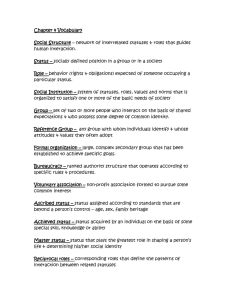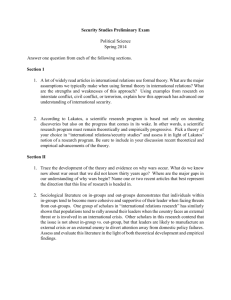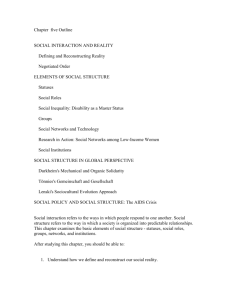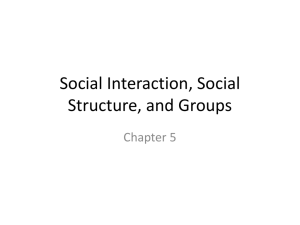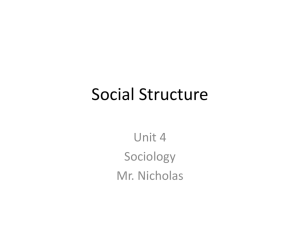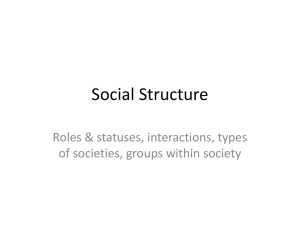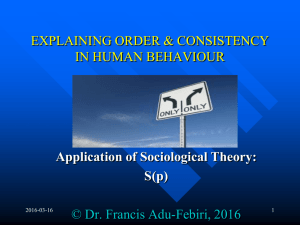Social Interaction and Reality - Fullerton College Staff Web Pages
advertisement
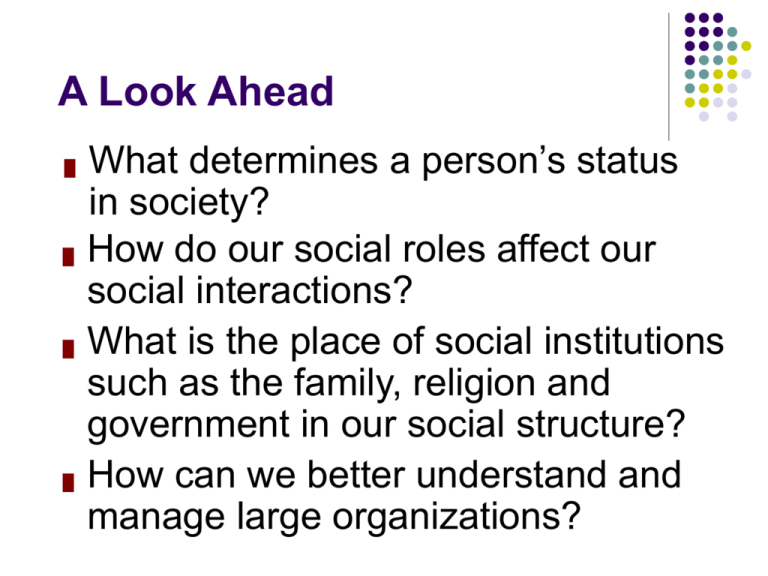
A Look Ahead █ █ █ █ What determines a person’s status in society? How do our social roles affect our social interactions? What is the place of social institutions such as the family, religion and government in our social structure? How can we better understand and manage large organizations? Social Interaction and Reality █ Response to someone’s behavior based on meaning attached to his or her actions – Ability to define social reality reflects group’s power within society Subordinate groups challenge traditional definitions and begin to perceive/experience reality in new way Social Interaction and Reality Social Structure: The way in which a society is organized into predictable relationships. Social structure is essential because it creates order and predictability in a society Social structure gives us the ability to interpret the social situations we encounter. Elements of Social Structure Statuses █ Status: Socially defined positions within a large group or society – Person can hold more than one status at same time Ascribed and Achieved Status Ascribed status: Status one is born with █ Achieved status: Status one earns █ Master status: Status that dominates other statuses and determines a person’s general position in society █ In U.S., ascribed statuses of race and gender can function as master statuses Elements of Social Structure █ Figure 5.1: Social Statuses Social Roles Social roles are sets of expectations for people who occupy a given status Role Conflict Role conflict is the challenge of occupying two social positions simultaneously Social Roles █ Social role: Set of expectations for people who occupy a given status Role conflict: When incompatible expectations arise from two or more social positions held by same person █ Role strain: Difficulties that arise when same social position imposes conflicting demands and expectations █ Social Roles █ Role exit: Process of disengagement from a role that is central to one’s identity to establish a new role – Doubt – Search for alternatives – Action stage – Creation of a new identity Groups Any number of people with similar norms, values, and expectations who interact with each other on a regular basis Every society composed of many groups in which daily social interaction takes place Primary group: small group with intimate, face-toface association and cooperation Secondary group: impersonal groups with little social intimacy or mutual understanding Table 5-1: Comparison of Primary and Secondary Groups Primary Group Secondary Group Generally small Usually large Relatively long period of interaction Relatively short duration, often temporary Intimate, face-to-face association Little social intimacy or mutual understanding Some emotional depth to relationships Relationships generally superficial Cooperative, friendly More formal and impersonal In-Groups and Out-Groups In-groups: any groups or categories to which people feel they belong Out-groups: any groups or categories to which people feel they do not belong Conflict between in-groups and out-groups can turn violent on a personal as well as political level Tension between groups sharpen the groups’ boundaries and give people a clearer social identity. In-group promotes solidarity and sense of purpose and belonging In-groups can also foster ethnocentrism Members of in-groups generally hold overly positive views of themselves and unfairly negative views of various out-groups The result is prejudice where a double standard emerges: The traits of our in-groups come to be viewed as virtues, while those same traits in out-groups are seen as vices Studying Small Groups Size of Group Groups size has an important impact on the nature of social interaction The smallest group size is know as a Dyad a twomember group Triad: A three-member group Smaller groups have greater interaction opportunities Understanding Groups Studies have shown that the smaller the group, the more direct, personally satisfying and emotionally intense the interaction. One side effect of small groups is that they require continuing active participation, thus making it a fragile relationship As group size increases, interaction decreases but stability increases. Understanding Groups Physical Anonymity As the size of the group increases, so does physical anonymity Group conformity is also more likely to take place. Group Conformity Solomon Asch (1952) - conducted a study of visual perception One-third of all subjects chose to conform by answering incorrectly. Are we willing to compromise our own judgment to avoid the discomfort of being different? “Groupthink” Groupthink - the tendency of group members to conform, resulting in a narrow view of some issue Group members often seek agreement that closes off other points of view. - Space Shuttle - Iraq war Reference Groups █ Reference group: Any group individuals use for evaluating their own behavior Reference Groups Reference groups set and enforce standards of conduct and belief Reference groups serve as a standard against which people can evaluate themselves and others Social Networks and Technology A social network is a series of social relationships that links a person directly to others, and indirectly links them to still more people. A network includes people we know of – or who know of us Network ties often give us the sense that we live in a small world Milgram study – six degrees of separation Virtual Worlds █ With advances in technology, people can maintain social networks electronically – Avatar: 3-D model, 2-D icon, or constructed personality provided by an Internet site – Castells views electronic social networks as fundamental to new organizations and growth of existing businesses and associations Networking is a valuable skill to have when job-hunting Advances in technology, such as browsing web pages or text-messaging, help us to maintain social networks. Social Institutions Organized patterns of beliefs and behavior centered on basic social needs Social institutions provide insight into the structure of society Functionalist View Five major tasks (functional prerequisites) 1. Replacing personnel 2. Teaching new recruits 3. Producing and distributing goods and services 4. Preserving order 5. Providing and maintaining a sense of purpose Social Institutions Conflict View Major institutions help maintain privileges of most powerful individuals and groups within society Social institutions have inherently conservative nature Social institutions operate in gendered and racist environments Table 5-3: Stages of Sociocultural Evolution Societal type First appearance Characteristics Hunting-andgathering Beginning of human life Nomadic; reliance on readily available food and fibers Horticulture About 10,000 to 12,000 years ago More settled; development of agriculture and limited technology Agrarian About 5,000 years ago Larger, more stable settlements; improved technology and increased crop yields Industrial 1760-1850 Reliance on mechanical power and new sources of energy; centralized workplaces; economic interdependence; formal education Post industrial 1960s Reliance on services, especially the processing and control of information; expanded middle class Postmodern Latter 1970s High technology; mass consumption of consumer goods and media images; crosscultural integrations Ferdinand Tönnie’s Gemeinschaft and Gesellschaft Gemeinschaft (guh-MINE-shoft) Gemeinschaft is defined as a small community in which people have similar backgrounds and life experiences. Gesellschaft (guh-ZELL-shoft) Gesellschaft is defined as a large community in which people are strangers and feel little in common with other community residents Table 5-3: Comparison of the Gemeinschaft and Gesellschaft Lenski’s Sociocultural Evolution Approach █ Postindustrial and Postmodern Societies – Postindustrial society: Economic system engaged primarily in processing and controlling information – Postmodern society: Technologically sophisticated society preoccupied with consumer goods and media images Regulating the Net █ The Issue – Technological innovations changed the way we shop and share information – Can communicate with others instantaneously online – People who use complex communication system without understanding underlying technology create potential for misuse Regulating the Net █ The Setting – Internet is especially important to young people’s interactions • By 2005, 87% of those ages 12 to 17 had used the Internet • 11 million teens went online everyday • Majority of teens now text-message or visit online social networking sites Regulating the Net █ Sociological Insights – Internet not a level playing field – Conflict theorists documented gap between White and Black or Hispanic youths using electronic communication – Interactionists investigated implications of online communication for everyday social interaction – Feminist researchers noted that females embrace Internet more than men Regulating the Net █ Policy Initiatives – Self-regulation outstripping government regulation – Net neutrality: Government should remain nonselective or neutral toward online content – Concern that information gathered over Internet is being shared in ways unknown to online users Figure 5-2: Identity Information Revealed Online by College Students
